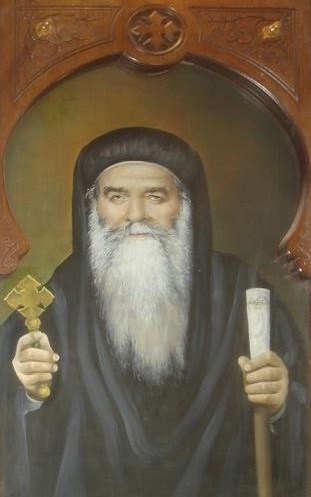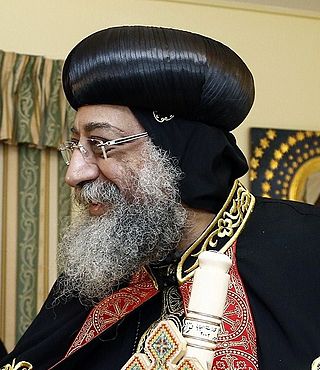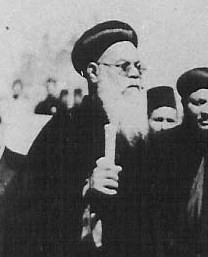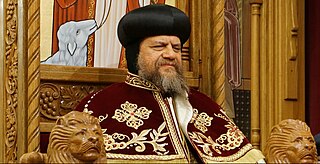
The Coptic Orthodox Church, also known as the Coptic Orthodox Patriarchate of Alexandria, is an Oriental Orthodox Christian church based in Egypt, in Africa and the Middle East. The head of the church and the See of Alexandria is the pope of Alexandria on the Holy Apostolic See of Saint Mark, who also carries the title of Father of fathers, Shepherd of shepherds, Ecumenical Judge and the 13th among the Apostles. The See of Alexandria is titular. The Coptic pope presides from Saint Mark's Coptic Orthodox Cathedral in the Abbassia District in Cairo. The church follows the Coptic Rite for its liturgy, prayer and devotional patrimony. Christians in Egypt total about 10 million people, and Coptic Christians make up Egypt's largest and most significant minority population, and the largest population of Christians in the Middle East and North Africa (MENA).

Pope Shenouda III was the 117th Pope of Alexandria and Patriarch of the See of St. Mark. His papacy lasted 40 years, 4 months, and 4 days, from 14 November 1971 until his death.

Pope Cyril VI of Alexandria also called Abba Kyrillos VI, Coptic: Ⲡⲁⲡⲁ Ⲁⲃⲃⲁ Ⲕⲩⲣⲓⲗⲗⲟⲥ ⲋ̅ ;, was the 116th Pope of Alexandria and Patriarch of the See of St. Mark from 10 May 1959 to his death.

The pope, also known as the Bishop of Alexandria or the Coptic pope, is the leader of the Coptic Orthodox Church, with ancient Christian roots in Egypt. The primacy in the Coptic pope, similar to the Catholic belief in the Bishop of Rome as successor to Saint Peter, is rooted in his role as successor to Saint Mark. The current holder of this position is Pope Tawadros II, who was selected as the 118th pope on November 18, 2012.
Pope John XVIII of Alexandria (Abba Youannis), 107th Pope of Alexandria & Patriarch of the See of St. Mark. Pope John XVIII was born in Fayoum, Egypt. His lay name was Joseph. He became a monk in the Monastery of Saint Anthony. At the departure of Pope Mark VII, he was unanimously chosen to succeed him. He was ordained at the church of Saint Mercurius Church in Coptic Cairo, on Sunday, 15 Paopi, 1486 A.M. (23 October 1769 AD)

Pope Mark VIII of Alexandria (Abba Marcos VIII), 108th Pope of Alexandria & Patriarch of the See of St. Mark.

Pope Joseph II of Alexandria (Abba Yousab II) was the 115th Pope of Alexandria & Patriarch of the See of St. Mark.

The Coptic Orthodox Church in Wales has two churches in Wales. The first is in South Wales and the other in North Wales.
The Holy Synod of the Coptic Orthodox Church of Alexandria is the highest Orthodox authority in the Coptic Orthodox Church. It formulates the rules and regulations regarding matters of the Church's organisation and faith.

The Coptic Orthodox Church of Alexandria has several churches in Great Britain and Ireland under the jurisdiction of four diocesan bishops.

The Seat of the Coptic Orthodox Pope of Alexandria is historically based in Alexandria, Egypt. It is commonly known as the Holy See of Saint Mark, to whom the Coptic Pope claims to be the legitimate successor.

Saint Mark's Coptic Orthodox Cathedral is a Coptic church in Alexandria, Egypt. It is the historical seat of the Pope of Alexandria, the head of the Coptic Orthodox Church.

Coptic Cairo is a part of Old Cairo which encompasses the Babylon Fortress, the Coptic Museum, the Hanging Church, the Greek Church of St. George and many other Coptic churches and historical sites. It is believed in Christian tradition that the Holy Family visited this area and stayed at the site of Saints Sergius and Bacchus Church. Coptic Cairo was a stronghold for Christianity in Egypt both before and during the Islamic era, as most of its churches were built after the Muslim conquest of Egypt in the 7th century.
The Church of the Virgin Mary in Haret Zuweila is the oldest church in the district of Haret Zuweila, near the Fatimid section of Cairo. It was probably built around the AD 10th century, though it is first mentioned in writing in the early 12th century on the occasion of the consecration of the new bishop of Cairo under Macarius' Papacy. The Church of the Virgin Mary in Haret Zuweila was the seat of the Coptic Orthodox Pope of Alexandria from c. 1400 AD to 1520 AD.

Saint Mercurius Church in Coptic Cairo is a Coptic Orthodox church situated just to the north of the Babylon Fortress in Old Cairo among a group of important churches, and within the area known as the Abu Sayfayn Cloister is to be found three churches and a convent. One of these churches, dedicated to Saint Mercurius, and is the largest in the district of ancient Babylon.
Saint Mary Coptic Orthodox Church in Haret el-Roum or the Church of the Virgin of Relief is a Coptic Orthodox church in al-Ghūrīya, Cairo near the Convent of Saint Theodore.

Serapion is the first hierarch and bishop of the Coptic Orthodox Diocese of Los Angeles, Southern California, and Hawaii. He was born in Assiut, Kingdom of Egypt on November 10, 1951. Following his graduation from the Faculty of Medicine at Assiut in 1975, he practiced medicine in Aswan before becoming a monk.

Mercurius was a Roman soldier of Scythian descent who became a Christian saint and martyr. He was born in the city of Eskentos in Cappadocia, in Eastern Asia Minor. According to Christian tradition, he was the soldier who killed Julian the apostate during his campaign in Persia. Saint Mercurius was also widely known by his Arabic-language name Abu-Sayfain, Abu-Sifin or Abu-Sefein in Egyptian Arabic which means "father of two swords", referring to the second sword given to him by the Archangel Michael.













